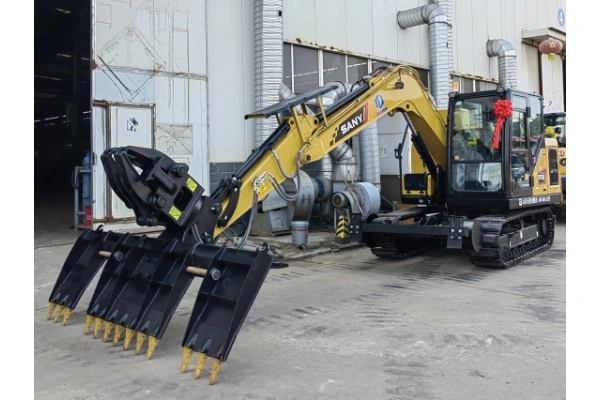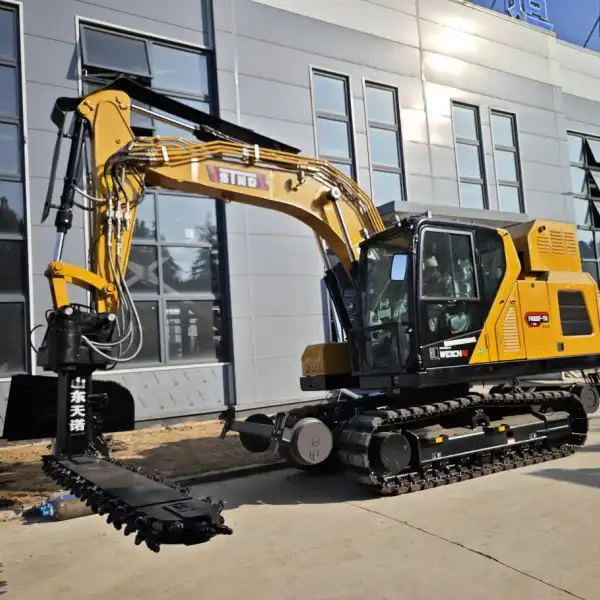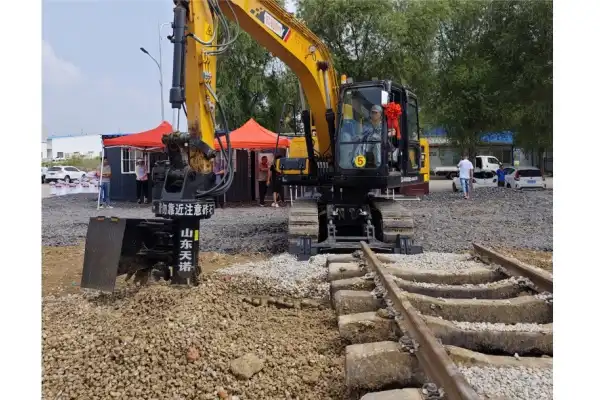What is railroad maintenance?
Railroad maintenance is the crucial process of keeping railway infrastructure and equipment in optimal condition to ensure safe, efficient, and reliable transportation. This comprehensive approach encompasses various activities, including track inspection, repair, and the use of specialized railroad maintenance attachments. From sleeper changing machines to ballast cleaning equipment, these attachments play a vital role in preserving the integrity of rail systems, enhancing operational efficiency, and minimizing service disruptions.

Key Focuses of Railroad Maintenance
Track Inspection and Repair: Ensuring Safe Rail Travel
Track inspection and repair form the backbone of railroad maintenance. Regular inspections help identify potential issues before they escalate into serious problems. Maintenance crews use advanced technologies like ultrasonic testing and track geometry cars to detect rail defects, misalignments, or wear patterns that could compromise safety.
When issues are identified, repair work begins promptly. This may involve replacing worn-out rails, tightening loose fasteners, or addressing track geometry problems. Specialized equipment like rail grinders and tamping machines are employed to restore track to its optimal condition, ensuring smooth and safe train operations.
Ballast Cleaning: Maximizing Track Support and Drainage
Ballast, the crushed stone beneath and around railroad tracks, plays a crucial role in providing stability and drainage. Over time, ballast can become contaminated with fine particles, reducing its effectiveness. Ballast cleaning is essential to maintain proper track support and drainage.
Modern ballast cleaning machines use vibrating screens and conveyor systems to remove debris and restore ballast to its original condition. This process not only improves track stability but also extends the life of other track components by reducing moisture retention and preventing premature deterioration.
Equipment Upkeep: Maintaining Rolling Stock Efficiency
Beyond track maintenance, the upkeep of rolling stock – locomotives, freight cars, and passenger coaches – is equally important. Regular inspections, servicing, and repairs of these vehicles ensure they operate safely and efficiently.
Maintenance facilities equipped with specialized tools and diagnostic equipment conduct routine checks on braking systems, wheel sets, and other critical components. This proactive approach helps prevent breakdowns, reduces operational costs, and enhances the overall reliability of rail services.

Types of Railroad Maintenance
Preventive Maintenance: Proactive Measures for Rail Systems
Preventive maintenance is a proactive approach aimed at averting issues before they occur. This strategy involves scheduled inspections, routine replacements, and systematic upgrades of rail infrastructure and equipment. By adhering to a well-planned preventive maintenance schedule, railway operators can significantly reduce the likelihood of unexpected failures and costly emergency repairs.
Regular tasks in preventive maintenance include lubrication of moving parts, adjustment of track components, and replacement of wear-prone items before they reach critical condition. This approach not only enhances safety but also optimizes the lifespan of railway assets, leading to long-term cost savings and improved operational efficiency.
Corrective Maintenance: Addressing Urgent Railway Issues
Despite best preventive efforts, unexpected issues can still arise in rail systems. Corrective maintenance addresses these immediate problems to restore normal operations quickly and safely. This type of maintenance is reactive, focusing on fixing defects, breakdowns, or damages as they occur.
Corrective maintenance might involve emergency track repairs following extreme weather events, addressing sudden equipment failures, or responding to accidents. The goal is to minimize downtime and ensure the railway system returns to full functionality as swiftly as possible, often requiring rapid mobilization of maintenance crews and equipment.
Predictive Maintenance: Leveraging Data for Rail Upkeep
Predictive maintenance represents the cutting edge of railway maintenance strategies. By leveraging advanced sensors, data analytics, and machine learning algorithms, predictive maintenance aims to forecast potential failures before they happen. This approach allows for more precise scheduling of maintenance activities, optimizing resource allocation and minimizing unnecessary interventions.
For instance, sensors on tracks and rolling stock can continuously monitor vibrations, temperature, and other parameters. When these readings indicate a trend towards potential failure, maintenance can be scheduled preemptively. This data-driven approach not only enhances safety and reliability but also contributes to significant cost savings by reducing unplanned downtime and extending the life of railway assets.

Case Studies: Accident Prevention Success Stories
Revolutionizing Ballast Cleaning
The company can clean up to 400 meters of track per hour, a substantial improvement over traditional methods. By maintaining optimal ballast conditions, Rail has seen a reduction in track-related incidents and improved overall rail performance. This case study demonstrates how advanced maintenance equipment can contribute to safer and more reliable railway operations.
TianNuo Machinery: Innovating Railway Maintenance Equipment
TianNuo Machinery has been at the forefront of developing cutting-edge railroad maintenance attachments. Their range of equipment, including sleeper changing machines and ballast cleaning systems, has been instrumental in enhancing maintenance efficiency for numerous railway operators.
One notable success story involves TianNuo's ballast screening bucket, which has been adopted by several major rail networks. This attachment allows for quick and effective cleaning of ballast without the need for large, dedicated machines. Users have reported significant time and cost savings, along with improved track quality, leading to fewer track-related incidents and smoother rail operations.
Track Cleaning: Enhancing Rail Performance
In a notable case, a major European railway adopted cleaning system and saw a 30% reduction in rail-related incidents over a two-year period. The improved cleanliness of tracks and fastenings led to better traction, reduced wear on rolling stock, and enhanced overall safety. This case underscores the importance of regular, thorough cleaning in maintaining rail infrastructure.
FAQ
How often should railroad tracks be inspected?
Railroad tracks should be inspected regularly, with frequency depending on usage. High-traffic lines may require daily visual inspections and more thorough checks weekly or monthly.
What are the main causes of railway accidents related to poor maintenance?
The main causes include track defects, worn-out components, inadequate ballast conditions, and malfunctioning signaling systems due to lack of proper maintenance.
How does weather affect railroad maintenance schedules?
Extreme weather conditions can accelerate wear and tear on tracks and equipment, necessitating more frequent inspections and maintenance. Seasonal maintenance plans are often implemented to address weather-related challenges.
What role does technology play in modern railroad maintenance?
Technology plays a crucial role through automated inspection systems, predictive maintenance algorithms, and advanced diagnostic tools that enhance the efficiency and effectiveness of maintenance operations.
How do railroad maintenance practices impact the environment?
Modern maintenance practices focus on sustainability, using eco-friendly materials and methods to minimize environmental impact. This includes proper disposal of waste materials and the use of energy-efficient equipment.
Railroad maintenance is a complex and vital process that ensures the safety, reliability, and efficiency of rail transportation systems. From track inspection and repair to equipment upkeep, each aspect plays a crucial role in maintaining a robust railway network. The adoption of preventive, corrective, and predictive maintenance strategies, coupled with innovative technologies and equipment, has significantly enhanced the effectiveness of maintenance operations. As demonstrated by the success stories of TianNuo Machinery, ongoing advancements in maintenance practices and equipment continue to drive improvements in rail safety and performance worldwide.
For those in the railway construction, maintenance, and management sectors looking for high-quality railroad maintenance attachments, TianNuo Machinery offers a comprehensive range of solutions. Their product lineup includes essential equipment such as railway sleeper changing machines, screening machines, and ballast cleaning systems. To learn more about TianNuo's railroad maintenance solutions or to inquire about specific equipment, contact us at raymiao@stnd-machinery.com.
References
- Federal Railroad Administration. (2022). Track and Rail and Infrastructure Integrity Compliance Manual. Washington, DC: U.S. Department of Transportation.
- International Union of Railways. (2021). Best Practices in Railway Maintenance and Operations. Paris: UIC Publications.
- American Railway Engineering and Maintenance-of-Way Association. (2023). Manual for Railway Engineering. Lanham, MD: AREMA.
- Profillidis, V.A. (2020). Railway Management and Engineering (4th ed.). London: Routledge.
- Lichtberger, B. (2021). Track Compendium: Formation, Permanent Way, Maintenance, Economics (3rd ed.). Hamburg: Eurailpress.
- Popovic, Z., & Lazarevic, L. (2022). Railway Track Maintenance Management. Cham: Springer International Publishing.
About Author: Arm
Arm is a leading expert in the field of specialized construction and railway maintenance equipment, working at Tiannuo Company. Tiannuo specializes in manufacturing a wide range of products, including railway maintenance equipment like railway sleeper changing machines and screening machines, excavator modification equipment such as excavator lifting cabs, various engineering arms for excavators, excavator accessories like digging buckets, and engineering vehicle auxiliary equipment like loader buckets.

